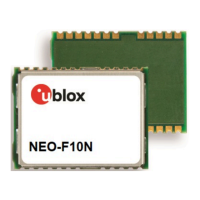NEO-F10N-Integration manual
Appendix
A Migration
u-blox is committed to ensure that products in the same form factor are backwards compatible
over several technology generations. This section describes important differences to consider when
migrating from u-blox M8 to u-blox F10.
A.1 Hardware changes
Table 13 lists the key hardware-related changes between NEO-F10N and the NEO-M8 modules.
Feature Change Action needed / Remarks
Absolute
maximum ratings
Maximum input voltage for PIOs is
changed to VCC + 0.3 V in NEO-F10N.
HW change is required if main supply voltage source is not
within the specified range.
VCC supply range
NEO-F10N: 2.7 V - 3.6 V
NEO-M8M: 1.65 V - 3.6 V
HW change is required when migrating from a NEO-M8M
design that uses less than 2.7 V VCC supply.
V_BCKP supply
range
NEO-F10N: 1.65 V - 3.6 V
NEO-8Q/M8N/Q/J/M: 1.4 V - 3.6 V
HW change is required when migrating from a NEO-8Q or
NEO-M8 design that uses less than 1.65 V V_BCKP supply.
Backup current
NEO-F10N:
I_BCKP = 31 µA
NEO-8Q/M8N/Q/J/M:
I_BCKP = 15 µA
The hardware backup current in NEO-F10N is higher than in
NEO-8Q and NEO-M8 modules.
Check that the backup battery capacity is still suitable for the
target design/application requirements.
Power
consumption
NEO-F10N peak current: 100 mA
NEO-8Q/M8 peak current: 67 mA
In u-blox F10, the average current consumption of acquisition
and tracking state is smaller than in u-blox 8/M8. However, in
terms of peak current, I_VCC is slightly higher in u-blox F10
than in u-blox 8/M8.
Ensure that the power supply is still able to provide clean and
stable voltage with the higher current demand in NEO-F10N.
Pin-out 1:1 pin-out mapping with NEO-8Q/
M8N/Q/J/M modules.
NEO-M8M (pin 14) is reserved and NEO-F10N (pin 14) is
LNA_EN. NEO-M8M designs can be updated to use pin 14 on
NEO-F10N for external LNA and antenna control.
VDD_USB (pin 7) name changed to Reserved in NEO-F10N
since USB interface is not available.
Communication
interfaces
Due to the hardware implementation,
only UART interface is available on
NEO-F10N.
Communication with host can only be done by UART
interface.
Dual-band L1+L5
SAW-LNA-SAW
RF front-end
NEO-F10N has two SAW filters and
one LNA on the RF path for both L1
and L5 along with a Band 13 notch
filter for L1, which allows the use of a
passive antenna.
The Band 13 notch filter and the SAW filters used in NEO-
F10N provide improved out-of-band immunity compared to
NEO-8Q and NEO-M8 modules.
RF path
NEO-F10N supports dual-band L1/L5
GNSS signals.
NEO-F10N noise figure: 3 dB for L1 and
L5
NEO-8Q/M8 noise figure: 2 dB
Antenna supporting dual-band L1/L5 is required with NEO-
F10N.
Check that the RF path (antenna and filtering) is suitable for
all of the GNSS signals in use.
RESET_N
NEO-F10N: clears RTC time and BBR
contents (GNSS orbit data).
NEO-8Q/M8: clears only RTC time.
TTFF after resetting NEO-F10N with the RESET_N pin is
similar to performing a cold start.
TTFF after resetting NEO-8Q/M8 modules is typically around
6 s in open-sky conditions.
UBXDOC-963802114-12193 - R02
Appendix Page 34 of 42
C1-Public

